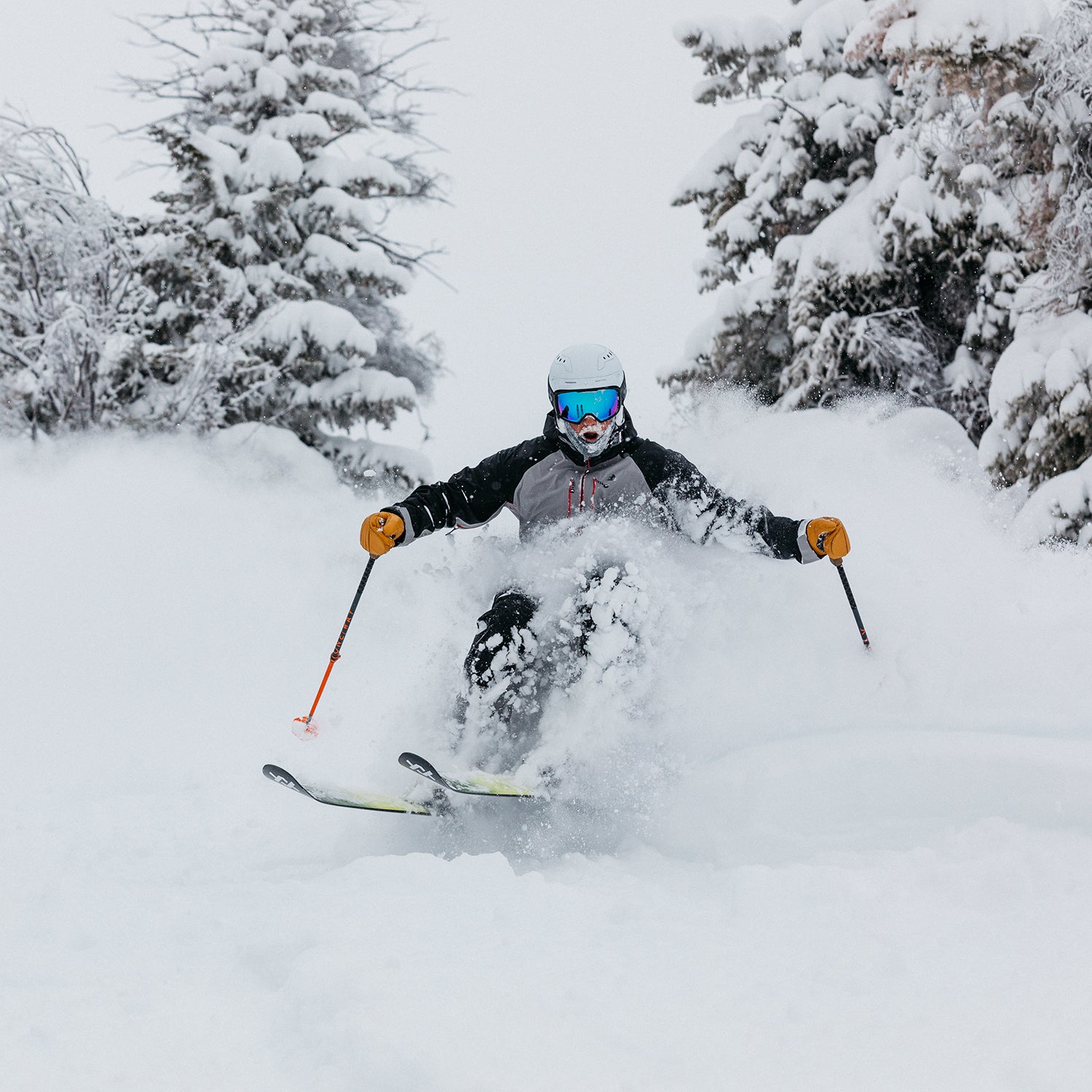This article was first published by .
Powder skis are fat skis designed to lift you up so you can get through deep snow—like really deep, best-day-ever snow. To encourage float and easy steering, powder skis feature wide waists (around 110 millimeters-plus), more tip and tail rocker than you’ll find in all-mountain skis, and lightweight materials to help them stay above the fray.
Not every skier needs a fat powder ski in their quiver, but if you’re lucky enough to frequent resorts that measure snowfall in feet rather than inches, dive into this list of 2024’s best powder skis to find the right tool to maximize any powder day.
Looking for the best women’s powder skis of 2024? You’ll find those here.
How We Test
Number of powder skis tested: 19
Number of testers:��24
Testing location: Sun Valley, Idaho
Average age of tester:��39
Average height of tester:��5’9”
Average weight of tester: 170 lbs
Like every year, we invited a crew of seasoned industry professionals—ski instructors, ski shop employees, coaches, and former World Cup racers—to join us for a week-long gear test in , a resort known for its steep and manicured groomers, legendary bump runs, perfectly gladed tree runs, and of course, “the Burn,” sidecountry terrain that powder dreams are made of.
It’s well known that Sun Valley can sometimes get skunked when big storms dump on surrounding mountain ranges, so when it comes to testing powder skis at our annual gear test at the end of February, we always just hold our breath and hope for the best. This year, our prayers to Ullr were answered. One morning during the test week we woke up to more than 14 inches of fresh blanketing the base of the resort; in some of the bowls on the backside of the mountain, testers swore they were surfing through 20-plus inches thanks to wind effect.
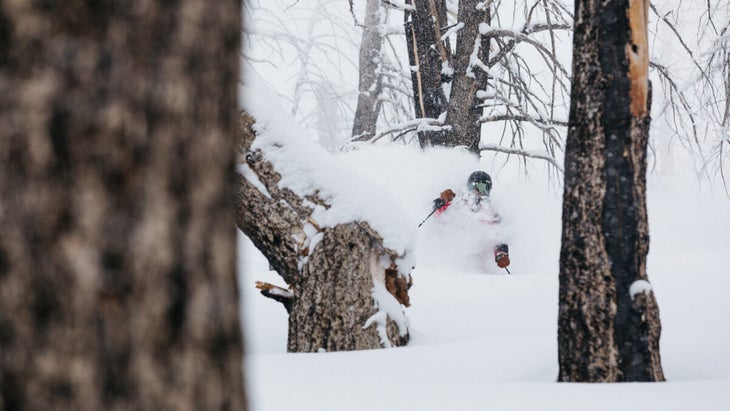
Suffice to say, we had ideal powder ski testing conditions. Our crew of 24 testers didn’t need much motivation to jump on the 19 powder planks entered into the test and let ‘em rip. At the end of each lap (or four), testers filled out digital scorecards with comments and impressions of how each pair of planks performed across various skill categories—from flotation and crud performance to stability at speed and responsiveness.
We asked them to identify each ski’s primary strengths, its weaknesses, who it’s designed for, and what terrain and snow conditions it’s most adept at. By the end of one epic day, we had enough hard data on the 19 pairs of skis tested to make your head spin, and we used it all to bring you these reviews of the best powder skis of the year.
How to Use These Reviews
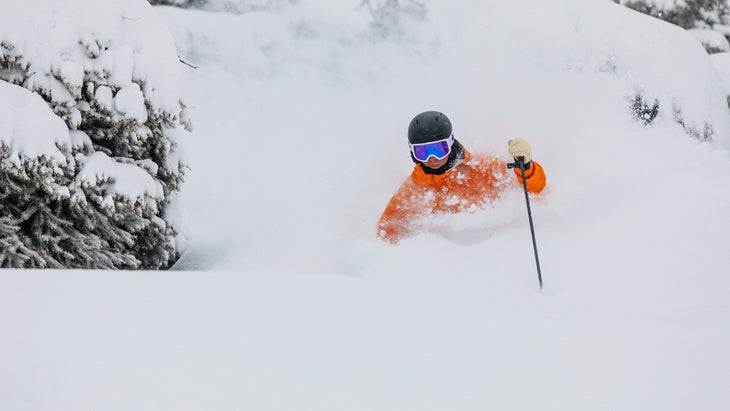
The following skis appear in ranked order, with the ski that tested best at the SKI/���ϳԹ��� 2024 gear test in Sun Valley listed at the top. In each review, we list the ski’s overall score, a product of how eight female testers scored the ski across eight different skills categories: Flotation; Crud Performance; Versatility; Playfulness; Responsiveness; Quickness; Stability at Speed; and Forgiveness. SKI’s scoring system exists to determine and call attention to the skis that most impressed our testers, a crew of ski industry professionals and advanced and expert skiers from across the country.
We believe the sticks listed here set the benchmark for what an all-mountain ski is designed to do. That said, remember that ski testing (and skiing) is somewhat subjective. While we’re big fans of the category-winning , it may not be the best choice for every skier. So don’t just look at a ski’s score—read our testers’ feedback to understand the nuances of each ski and who it’s best suited to. Otherwise, you might wind up with a great ski, just not the right ski for you.
Meet the Testers
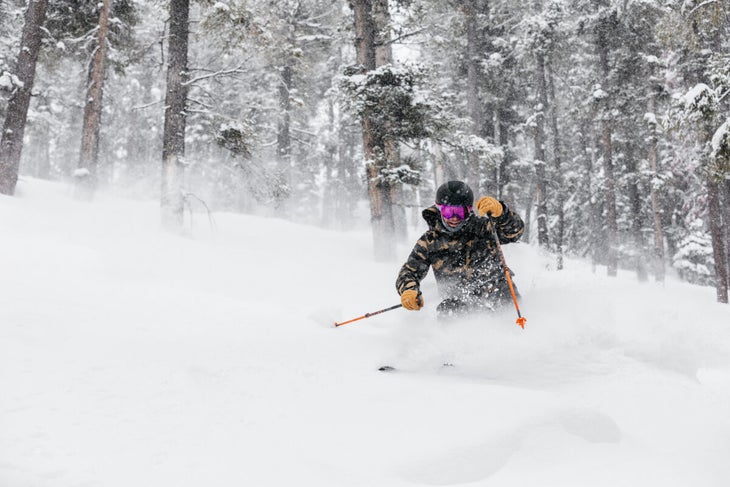
Luke Larsen
Age: 40 | Height: 5′10″ | Weight: 195 lbs
Larsen owns and operates Salt Lake City’s Ski Shop with his brother, Zac Larsen. Larsen practically grew up in the shop, a family-owned business, and spent his free time chasing gates on the Snowbird Ski Team. He has been gear tester for SKI for more than a decade.
Avery Pesce
Age: 40 | Height: 5′6″ | Weight: 138 lbs
Pesce lives in Whitman, Mass., and calls the ski areas of Vermont and New Hampshire home. She’s an expert skier with an aggressive style that she applies to any and all type of terrain and snow conditions. Safe to say that as the head ski buyer for in Newton, Mass., she knows a thing or two about skis—how they’re built, and how they perform.
Otto Gibbons
Age: 23 | Height: 5′6″ | Weight: 135 lbs
Gibbons has spent 22 of his 23 years on this earth on skis. The son of Sturtevants Sports’ head buyer, Tracy Gibbons, Otto has basically lived in the ski shop his whole life and has worked there for the past seven years as a hardgoods buyer. If he’s not in the shop, he’s ripping laps at Washington’s Crystal Mountain.
The Reviews: The Best Powder Skis of the Year
Editor’s Choice: Salomon QST Blank ($800)
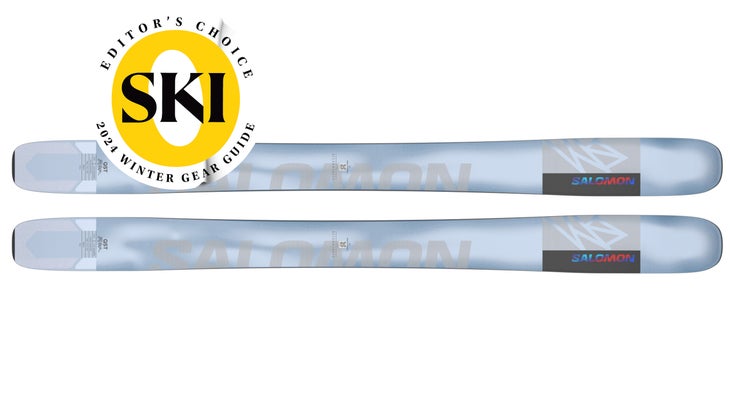
Overall score: 8.27/10
Dimensions (mm): 138-112-127
Available lengths (cm): 178, 186, 194
Radius (m): 17 (186)
Weight (per ski in grams): 2,220 (186)
Pros: Flotation, Quickness
Cons: Stability at Speed, Forgiveness
Except for new graphics, nothing has changed about the highly popular Salomon QST Blank for 2023-’24 season, and that includes how much skiers of all stripes love it. Proof: For the third year in a row, this unisex ski won the highest scores in the powder ski category from both male and female testers.
What we loved most about this ski is how quick and playful it is. The QST Blank features a full poplar wood core and no metal, which keeps it feeling light underfoot (2,220 grams per ski) and makes it extraordinarily nimble. For a pow ski, it also has a more moderate waist width at 112 millimeters, a healthy amount of traditional camber underfoot, and relatively short turning radius (17 meters in the 186-centimeter length), which translate to enhanced responsiveness and quicker edge-to-edge transitions. As a result, the QST Blank makes for a great powder ski for those who spend their time hunting for secret stashes in the glades and in tight, technical terrain.
We also appreciate how approachable the QST Blank is, with testers calling it a great powder option for intermediates to experts. “It’s very easy to figure out. Skiers of lower ability could handle it, but it still charges for the higher-ability skier,” commented Aspen-based ski shop technician John Jensen. One small critique: It’s not the most dependable at speed. A few testers noted a slight lack of stability when trying to plough through crud at mach speeds or opening it up when the terrain allowed. “It’s not a ski to go 100 miles-per-hour on,” noted race coach Chad Jacob, “but is that what we really want in this category?” For most skiers, the answer is no—no it’s not. What we want in a powder ski is flotation and fun, pop and pizazz, and the QST Blank delivers on those fronts in spades.
Read the full review for category scores, strengths, weaknesses, and tester feedback.
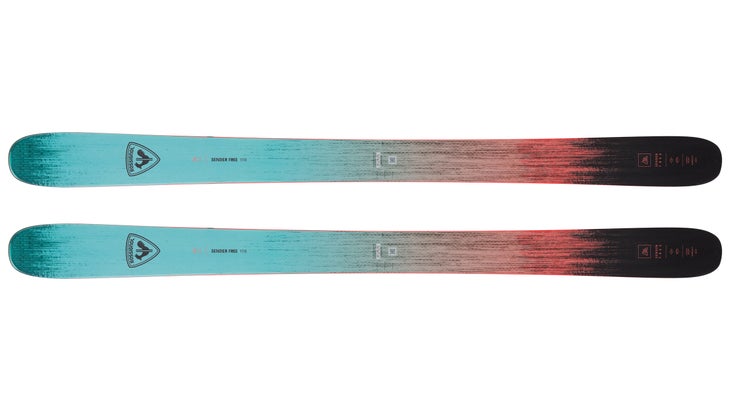
Overall score: 8.13/10
Dimensions (mm): 140-110-133
Available lengths (cm): 176, 184, 191
Radius (m): 20 (184)
Weight (per ski in grams): 2,200
Pros: Versatility, Playfulness
Cons: Forgiveness, Quickness
Fans of Rossignol’s Sender 106 Ti have been clamoring for a wider, more playful version that enhances the fun factor in deep snow. This season, Rossignol delivers with the brand-new Sender Free 110, a versatile powder ski for advanced and expert chargers. This ski is the perfect combination of power and playfulness thanks to its construction: a twintip profile allows for more effortless float, turn initiation, and turn release; a poplar wood core (sustainably sourced and PEFC-certified) is reinforced with a Titanal plate underfoot and a layer of Rossignol’s Diagofiber throughout the ski for enhanced power transfer; and vibration damping technology in the tip and tail smooth out terrain roughness and increase stability at speed. The result is a powder ski that can handle any terrain and any snow condition. “These skis are for the skier who wants to be able to pop and play in soft snow, but still likes to throw down long-radius turns with confidence,” reported park-rat turned all-mountain aficionado Jon Sexauer. If playfulness with a dose of power sounds like just what the doctor ordered for your powder mania, you can’t go wrong with the Sender Free 110.
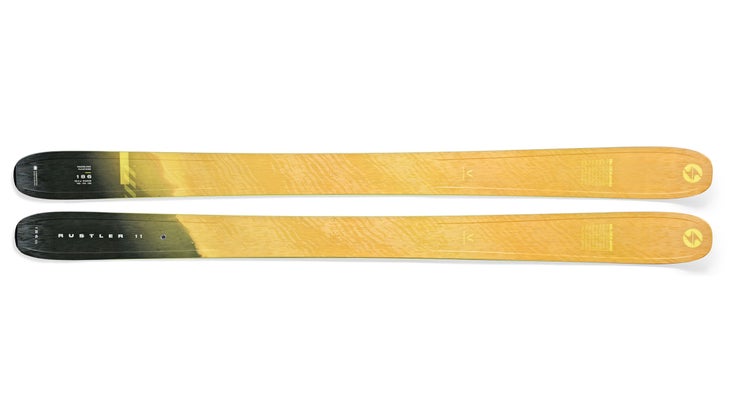
Overall score: 8.1/10
Dimensions (mm): 142-114-132
Available lengths (cm): 168, 174, 180, 186, 192
Radius (m): 19 (180)
Weight (per ski in grams): 2,650
Pros: Flotation, Playfulness
Cons: Forgiveness, Crud Performance
If you thought you liked the previous Rustler 11, wait until you meet the new and improved model that’s even more playful, energetic, and dynamic than its predecessor. The key construction updates include Blizzard’s new Freeride Trueblend Woodcore and FluxForm technology. In the core, three different densities of wood are strategically blended to adapt the stiffness throughout the ski. Add to that a Titanal plate underfoot, which reinforces the ski’s main energy transfer point, and two Titanal pieces that run the length of the edges but taper towards the tip and tail to reduce swing weight and torsional rigidity. The combination of these two technologies ensures that the Rustler 11 has the liveliness most of us look for in a powder ski, but enough backbone to handle variable snow conditions and hold up on edge. “Such a smooth flex pattern,” raved Jacob. “When you push it, it comes to life and explodes with energy, which advanced skiers will appreciate.” The downside of incorporating metal in a powder ski (besides additional weight) is that it often makes the ski less forgiving, and that proved true for the Rustler 11. Testers called it a ski best suited to those confident in their abilities and who charge the whole mountain with large-radius turns and higher speeds. So if you fancy yourself a Connery Lundin or Marcus Caston, you’ll dig the new Rustler 11.
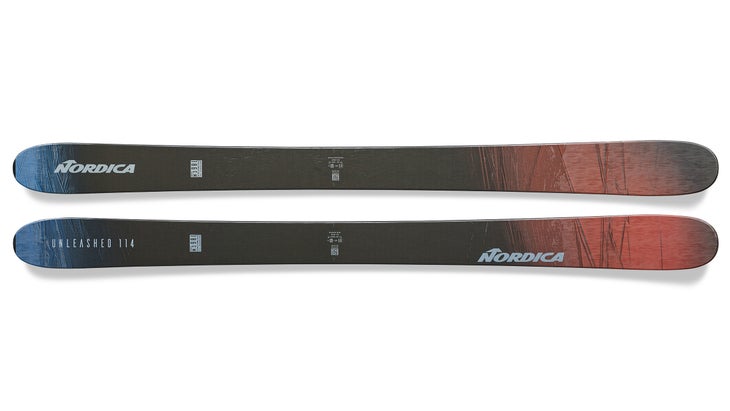
Overall score: 7.8/10
Dimensions (mm): 146-114-135
Available lengths (cm): 174, 180, 186, 191
Radius (m): 20.4 (186)
Weight (per ski in grams): 2,025
Pros: Crud Performance, Flotation
Cons: Forgiveness, Versatility
We’re running out of ways to talk about how steadfast and dependable Nordica skis are across the board—even in the Powder category. Though it’s got 14 millimeters on the Enforcer 100, and less metal in the core, the Unleashed 114 still skis like a fat-waisted all-mountain charger. “Soft snow is great, but it still skis well when the snow gets a bit choppy,” commented veteran tester and ski instructor Todd Casey. This ski’s stability in more unfavorable conditions can be traced to its construction: a wood core is reinforced with carbon and a sheet of Nordica’s Terrain Specific Metal (where the amount of metal that runs along the edge of the ski is adjusted based on the type of ski, so that the wider skis in the Unleashed lineup carry less metal). This layup makes the Unleashed 114 stiffer and burlier than many of the other powder skis we tested (which contain even less metal or no metal at all), giving it a leg up at the resort, where fresh powder tends to turn to tracked-out crud in a matter of runs. The downside to its beefier construction is that it can be a tad sluggish from turn to turn. Some testers noted that the Unleashed takes more active steering and may be best suited to advanced skiers with strong technical backgrounds. “It’s a charger that rewards strong inputs with precise turn-to-turn energy. But it won’t do any of the work for you,” summed up 6-foot-3 tester Jamie Klopp. If you’re willing to put more effort into it, the Unleashed 114 knows no bounds within the resort.
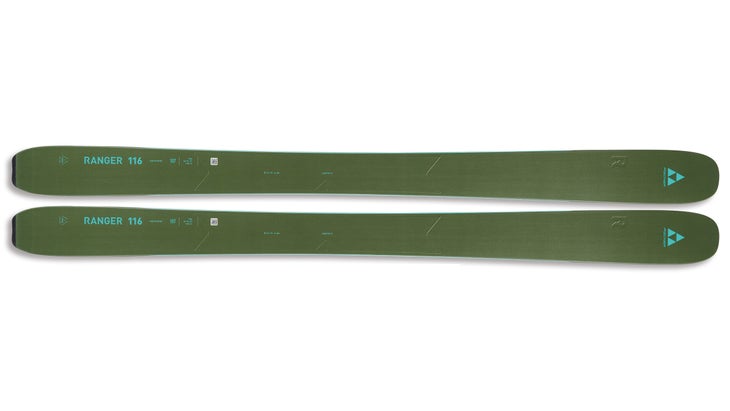
Overall score: 7.7/10
Dimensions (mm): 147-116-137
Available lengths (cm): 180, 187, 193
Radius (m): 20 (187)
Weight (per ski in grams): 2,150
Pros: Playfulness, Flotation
Cons: Versatility, Stability at Speed
With its girthy waist, it’s no surprise that the Ranger 116 scored high marks in flotation. But what really stood out to testers was this ski’s forgiving and playful performance in over a foot of fresh snow at the gear test in Sun Valley. Testers called the Ranger 116 exceptionally nimble and energetic. These traits can be traced to Fischer’s shaped Ti and Flex-Cut technologies, which tailor the amount of Titanal in the core and adapt its flex profile to the ski’s waist width to keep it lighter and more responsive despite its heft underfoot. “It’s a floaty pow ski with very quick feedback,” noted Luke Larsen, owner of The Lifthouse ski shop in Salt Lake City. “It’s very snappy for its width, which makes it fun to ski through bumps and trees.” While testers agreed the Ranger 116 can handle variable terrain and snow conditions, it’s still a fat powder ski that’s best reserved for the deepest days at resorts where the snow stays soft (read: Western snow). Expert skiers who drive their skis hard and want to push their limits in firmer conditions may find the Ranger 116 lacking. That said, testers called it one of the most accessible powder skis in our gear test, a ski that intermediates can tap into and enjoy as well as experts looking for fun, not work.
No. 6: Black Diamond Impulse 112 ($850)
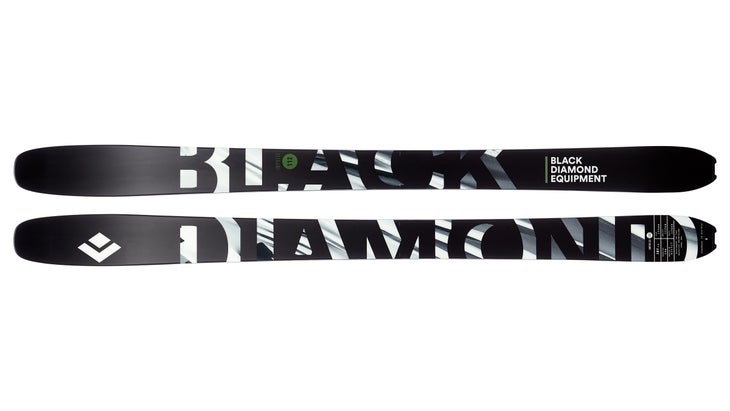
Overall score: 7.38/10
Dimensions (mm): 139-112-126
Available lengths (cm): 181, 186
Radius (m): 20 (181)
Weight (per ski in grams): 2,050
Pros: Flotation; Playfulness
Cons: Stability at Speed; Versatility
If you wake up to find more than a foot of fresh on the car, grab the Impulse 112 and beeline for the back bowls and the sidecountry. With its 112-millimeter waist, surfy, tapered tip, and lightweight construction with a full poplar core, this ski is designed to play in the pow without wearing you out. It shines in the soft stuff but testers also commended its ability to buckle down and cut through the crud when conditions deteriorate. “It’s surprisingly powerful for a ski from a brand that is associated with weight-conscious backcountry gear,” noted Sexauer. “The ski has enough guts to push it even on firmer snow, but it does get a little squirrely in the tips.” Testers’ advice: Keep it in fourth gear or lower and focus on the fun factor, and you won’t have any issues. Bonus: Because it’s on the lighter side and likes to seek out the untracked goods, the Impulse 112 is an ideal resort/backcountry hybrid setup. “It’s playful and fun in the softer snow at all pitch angles,” summed up Casey. “It’s a good option for inbounds when it’s deep and a touring ski when the backcountry calls.”
No. 7: Head Kore 111 ($975)
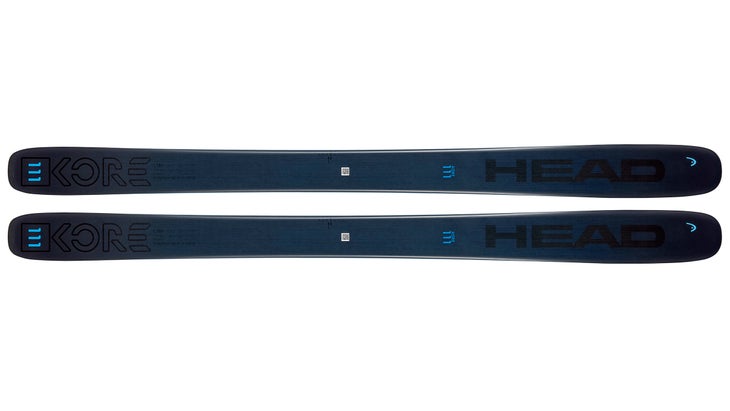
Overall score: 7.26/10
Dimensions (mm): 140-111-127
Available lengths (cm): 177, 184, 191
Radius (m): 21.1 (184)
Weight (per ski in grams): 1,890
Pros: Versatility, Playfulness
Cons: Forgiveness, Crud Performance
Over the years, the Head Kores (now available in six unisex models and four women’s models) have established themselves as the “every-man” skis. The Kore 111, featuring Head’s innovative lightweight Kore construction—which shaves weight wherever possible without sacrificing stability and performance—is no exception, with testers calling it an intermediate-friendly powder ski that isn’t beneath experts. “It’s a great ski that will spare you from your technical and tactical missteps,” noted Michael Rogan, team coach for the PSIA alpine demo team. You can thank the caruba/poplar core and lightweight graphene reinforcement for this ski’s minimal swing weight and softer flex, which makes it easier to command than some of the other powder skis on this list. “This ski has tons of energy and is playful in bumps and crud,” lauded Jacob. “This is a ski that wants to play for all skier types.” Other testers felt the same, calling the Kore 111 versatile not just in terms of skier ability, but in application. “It loves the deep stuff, but it’s easy to swing around in the tight trees and late-day crud,” commented Larsen. Just two small critiques: Though quick to initiate turns, the Kore 111 isn’t as fast to release out of them. With a 21.1-meter turning radius and a stiff tail that can feel a tad planky, you may have to work a little harder to fire off short-swing turns. And because it’s lighter, it doesn’t have the same knack for busting up crud or charging at speed that beefier skis have. Still, if you’re looking for a powder ski that can do more than just surf the soft stuff, the Kore 111 is a serious contender.
No. 8: K2 Mindbender 116C ($900)
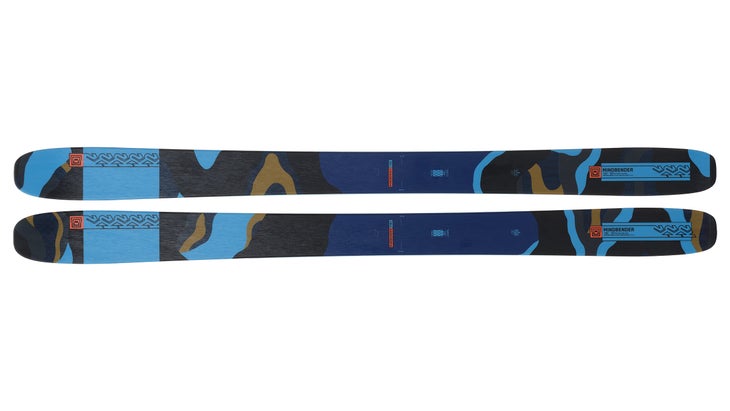
Overall score: 7.21/10
Dimensions (mm): 143-116-132
Available lengths (cm): 177, 182, 187, 194
Radius (m): 22.5 (187)
Weight (per ski in grams): 2,325
Pros: Flotation, Crud Performance
Cons: Versatility, Responsiveness
The newly updated Mindbender 116C has a new shape, new rocker profile, and now includes a layer of unidirectional flax, along with Mindbender C staples like an aspen veneer core and K2’s Spectral Braid reinforcement. The result is a powder-oriented Mindbender that’s primarily built to float, but can also hold its own in chunder and no longer protests when you rev up the engine. Testers agreed that the added flax layer does this ski a world of good when it comes to damping unwanted chatter when you’re charging. The flipside: it’s not the most responsive ski on the rack. It’s got a wide waist and a wide turning radius, which make it especially fun for surfing through powder, but it’s a little sluggish to respond to skier input. “Centered skiers rejoice: This is a ski that will motor through anything you put in front of it,” proclaimed tester Otto Gibbons, a hardgoods buyer for Sturtevant’s in Bellingham, Washington. “But it’s not for someone who actively drives the front of their boot. Adopt your West Coast surfer mentality.” If you fall into the progressive camp of skiers, this one’s for you.
No. 9: Völkl Blaze 114 ($750)
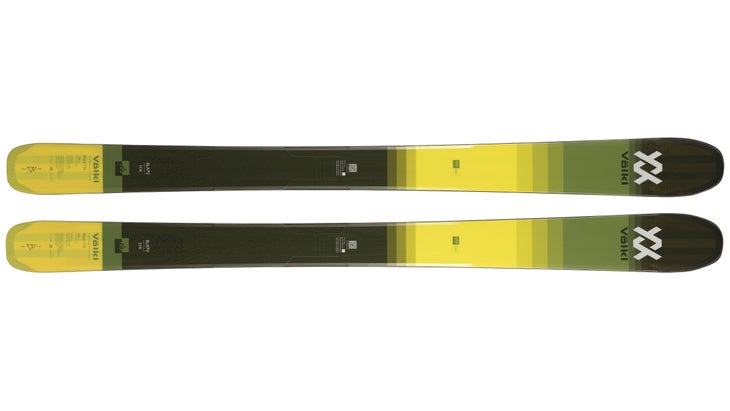
Overall score: 7.18/10
Dimensions (mm): 154-114-136
Available lengths (cm): 176, 184, 192
Radius (m): 18 (184)
Weight (per ski in grams): 1,995
Pros: Flotation, Stability at Speed
Cons: Quickness, Forgiveness
You have to give this relative featherweight major props for edging out other skis on this list in the Stability at Speed department. At 1,995 grams per ski (in the 184-centimeter length), the all-new Blaze is lighter than the majority of powder skis on this list and yet it still performs like a Völkl: It likes to charge. Thank the traditional camber underfoot, Titanal binding plate, and full sidewalls for the confidence-inspiring ride even in less than favorable conditions. “The Blaze might be the most stable crud ski I’ve been on,” claimed Sexauer. “It smooths out the chatter and makes crud feel like a groomer.” Though testers agreed the Blaze handles like a very wide all-mountain ski, it does have an area of expertise: deep snow. With 114 millimeters underfoot, it’s not the fattest powder board on this list, but it proved to be one of the floatiest at our test in Sun Valley. One word of caution: Like all Völkls, the Blaze 114 caters to the skilled technician—someone who knows how to pressure the front of the ski. Those who ski with a more upright stance and like to cruise may, like some of our testers, find the Blaze 114 a little lifeless. Tester Avery Pesce, a ski buyer for Boston Ski and Tennis, summed it up best: “Need a ski that’s bouncy, lively, and energetic? Look elsewhere. Looking to surf through the powder while you hoot and holler at how much fun you’re having because your skis are literally floating? Grab these skis.”
No. 10: Dynastar M-Free 118 ($1,000)
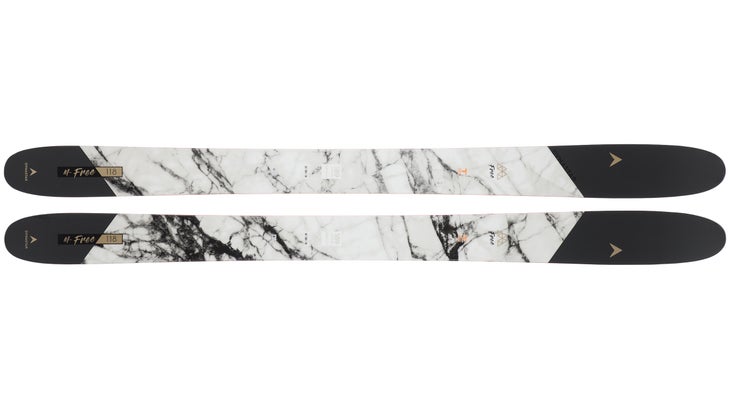
Overall score: 7.16/10
Dimensions (mm): 145-118-135
Available lengths (cm): 180, 189
Radius (m): 24 (189)
Weight (per ski in grams): 2,250 (189)
Pros: Flotation, Stability at Speed
Cons: Forgiveness, Versatility
Dynstar’s M-Free freeride line has been around for a minute now, and compared to the brand’s all-mountain oriented M-Pro line, it has a reputation for being softer and more playful. There’s some truth to that, since the M-Free skis feature lighter-weight constructions (primarily full wood or hybrid wood cores and fiberglass reinforcement versus the Titanal frame found in the M-Pro line) and progressive rocker profiles. Given that, some testers made the mistake of writing off the M-Free 118 as a playful powder pony before hopping on it, and were surprised to find that it was way more ski than they anticipated. “This is a true big mountain pow charger,” commented Larsen. “It’s ideal for strong skiers who want to be able to carve turns between stashes.” Other testers agreed and called out the ski’s ability to nuke large radius turns and hold steady at speed. Word to the wise though: Size really makes a difference with these fat powder planks. Most testers who normally gravitate towards a longer length (around 190cm) suggested sizing down if you’re looking for a more responsive, agile powder ski; otherwise you might find the tails a tad stiff and really feel the heft of the 118-millimeter waist. “This one skis a little longer than its length and could be a bit much for some skiers in the 189-centimeter length,” added Larsen. “But the 180-centimeter length makes for a much more manageable ski.” If you’re an advanced or expert skier who likes big sticks, keep these in wide open spaces and enjoy surfing the deep stuff. “It’s a heavy surfboard that’s built for a bigger ripper,” summed up Rogan. “It offers a big, trustworthy platform, but it’s still nimble enough with the tip and tail profile to pivot and surf any snow in your path.”
No. 11: Black Crows Nocta ($1,050)
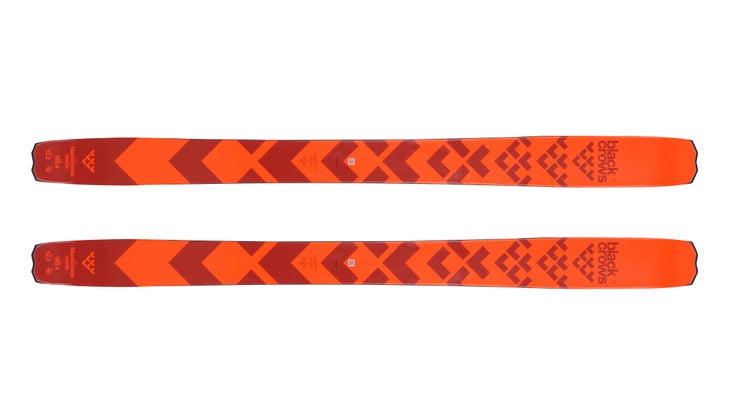
Overall score: 7.05/10
Dimensions (mm): 145-122-136
Available lengths (cm): 177.6, 185.5, 190.6
Radius (m): 19m (185.5)
Weight (per ski in grams): 2,025
Pros: Flotation, Playfulness
Cons: Stability at Speed, Versatility
Featuring the widest waist width in the powder category—a voluptuous 122 millimeters—the Nocta shocked no one by taking home the highest flotation scores at the SKI test in Sun Valley. These things are powder pontoons that float like a dream on the deepest of days—realistically, deeper than you might ever find at the resort, some testers acknowledged. Still, thanks to an updated profile that now includes traditional camber underfoot and a straighter sidecut, the Nocta can hold its own in crud and is surprisingly responsive despite its bulky build. “It astonished me how nimble, bouncy, and compliant this fat monster was,” noted Klopp. “It’s great in its element, which is soft snow without bumps,” added Rogan. But when conditions begin to deteriorate (as they inevitably do at the resort), the Nocta loses its edge over the other skis on this list. “It’s just a little too big to ski moguls effectively,” added Sexauer. “In beat-up snow it’s a challenge to tap into the ski’s more playful demeanor it shows in truly soft snow.” The Nocta isn’t exactly versatile and it won’t fit in every skier’s quiver, but if Ullr tends to deliver in your neck of the woods and you feed off powder frenzy, hop on board.
No. 12: Armada ARV 116 JJ UL ($975)
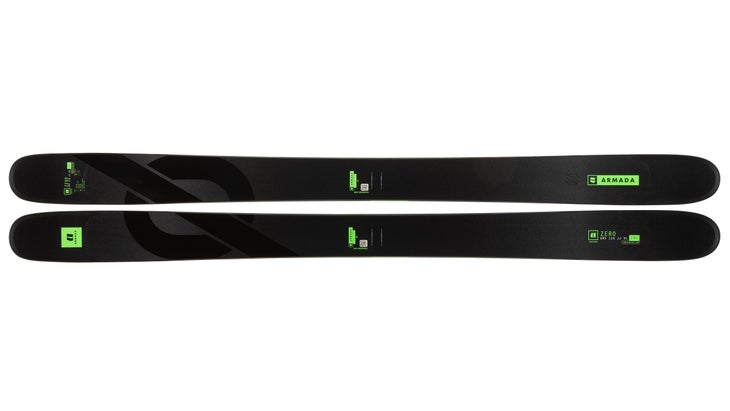
Overall score: 7.04/10
Dimensions (mm): 139-116-135
Available lengths (cm): 165, 175, 185, 192
Radius (m): 18 (185)
Weight (per ski in grams): 1,725
Pros: Playfulness, Flotation
Cons: Stability at Speed, Crud Performance
Playful skis have always been Armada’s bread and butter, and with the ARV 116 JJ UL, that heritage is on full display. It’s not hard to see why this ski is a favorite among Armada’s freeride athletes: it’s a true powder ski built to accommodate a more playful skiing style and maximize fun in the fluff. There’s nothing burly or intimidating about this updated version of the classic ARV 116 JJ (other than its fat waist width, perhaps). Featuring Armada’s lightest caruba core reinforced with fiberglass (no metal), this “UL” model is 25-percent lighter than the original (and significantly lighter than the other powder skis we tested). Even our hard-charging testers enjoyed the reduced swing weight, which translated to nimble and effortless turns in the powder stashes in Sun Valley’s glades. “It’s super simple to ski in deep snow, easy to pop from turn to turn, and capable of simple wiggles down the fall line,” noted Sexauer. With an 18-meter turning radius (in the 185-centimeter length), “tighter turns are its friend,” added Casey. Because it’s relatively light for its massive platform, this ski could also pull double-duty in the backcountry, where you’re more likely to find the bottomless pow this ski was made for. At the resort, testers noticed that when they did hit bottom (as you’re likely to do once stashes get tracked out), the ARV 116 JJ UL didn’t show the same confidence-inspiring stability some of the burlier skis in this category demonstrated. “It’s on the softer side, so it struggles a little in crud,” noted Jensen. “It gets a little jumpy and nervous when you hit firmer snow and higher speeds,” added Drew Stoll, who found the ski less reliable on Sun Valley’s infamous steep groomers. But the real downside to this poppy, lively powder ski according to Larsen: “It doesn’t come with a lifeguard for all the deep pow you’ll be swimming in.”
Frequently Asked Questions
What are the best powder skis?
- Salomon QST Blank
- Black Diamond Impulse 112
- Head Kore 111
- K2 Mindbender 116C
- Völkl Blaze 114
- Dynastar M-Free 118
- Black Crows Nocta
- Armada ARV 116 JJ UL
What are powder skis?
Generally speaking, powder skis (or deep snow skis) are fat. They tend to have 110mm-plus waist widths, generous rocker profiles, and very large turn radii. While they float like a dream in soft snow, many powder skis can perform well in choppy snow as well, and a very special few—most notably the Nordica Unleashed 114—can actually hold an edge quite well on groomed terrain. For the most part, however, these skis are rarely defined as one-ski quiver options and are instead used only when conditions warrant, e.g. powder days.
Who are powder skis for?
Any ski wider than 105mm underfoot is best suited to a skier who gets to ski soft and deep snow more often than not. These wide skis are typically made of lighter materials, feature less metal in the core, and less effective edge, meaning they are not the best tools to handle hard snow, groomers, or bumps. Big boards will enhance any real powder day, but may feel cumbersome in anything less than five inches of fresh snow.
What length powder ski should I buy?
Because of the increased amount of rocker built into most powder skis, it’s suitable to have longer skis for deep snow to increase the amount of usable edge on hard and variable snow. Shorter powder skis will likely float and feel more nimble than longer versions, but can also sometimes feel like riding a pogo stick due to the increased floppiness that is caused by generous rocker in the tip and tails. .
How wide is too wide for a resort ski?
Skilled skiers will be able to manage a wide ski (100mm-plus) in most conditions and will still be able to make these skis carve. But intermediate skiers still working on their skills may find wide all-mountain skis to be more work in the types of conditions you are likely to encounter at the resort. .
What’s the difference between men’s and women’s skis?
In truth, most skis are unisex and not gender-specific. Many brands produce the ski with the exact same construction technologies for both genders, but often create two different top sheets to appeal to men vs. women. A handful of brands are making truly women’s-specific skis, where the ski takes a woman’s physique into account when building the ski. Men and women can ski on the same ski but may want to choose different lengths depending on their height and their skiing ability.


